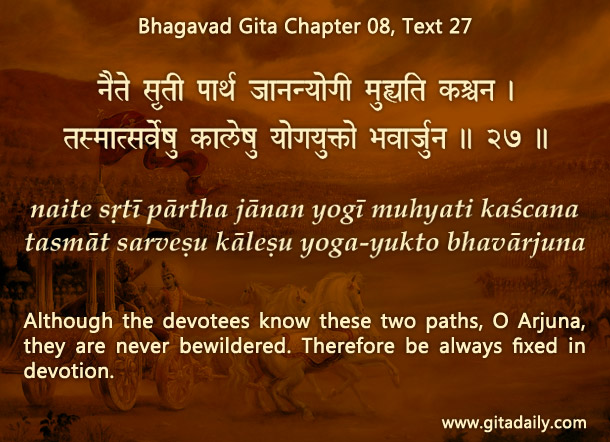
Death is life’s final exam. We are eternal souls transmigrating through various temporary bodies. Death is our opportunity to attain eternal life – if things work out right at that critical moment.
Let’s see what that means.
The post-mortem journey of seekers of eternity can go along two distinct trajectories, as mentioned in the Bhagavad-gita (08.23 – 08.26). Known in Vedic parlance as devayana (the path of the gods) and pitrayana (the path of the ancestors), both elevated, but only devayana led to eternity.
Success in devayana depended critically on multiple material logistics such as the time of day, the phase of the moon and its position in the sky at the time of death. As these logistics couldn’t be controlled, the only thing controllable was the time of death. The number of breaths allotted to a soul in a particular body is pre-decided by past karma. So, adept yogis would attempt to shuffle the moment of death to fall within an auspicious period by regulating their breathing frequency.
Understandably, achieving such precise adjustment was demanding and anxiety-inducing. Rescuing us from such anxiety, the Gita (08.27) endorses the path of grace, bhakti-yoga, and urges us to just stay connected with Krishna.
Bhakti-yoga relies not on uncertain circumstantial logistics, but on the supremely certain transcendental dynamics: Krishna’s sure reciprocation with the seeker’s sincere devotion. This yoga of love helps us cultivate conscientious remembrance of Krishna, gradually making his remembrance habitual. Those who remember him at the time of death, the Gita (08.05) assures, attain him, by his grace.
Drawing from their realizations of Krishna’s infinite grace, bhakti saints expand this assurance: even if we somehow can’t remember him at death, he will reward our lifelong service by thrusting himself into our consciousness, making his remembrance possible, probable and even inevitable.


Hare Krishna Prabhuji
PAMHO
After reading such an enlightening article, every sincere devotee should have faith in the assurance given by Lord Krishna and thereby feel secure at the time of death.
Hari Bol
Narottama das
Death uproots our identification of everything we are not. We are forced to leave behind our family, possessions and body. Stripped of everything there is only the subtle body and soul that move on. If we realize that our soul is an eternal part of Lord Sri Krishna and that our surrender unto Him is welcomed in divine loving reciprocation we are assured by Krishna that we don’t have to fear anything. In fact with the embrace of Krishna in our hearts He will lift us at the time of death from the boundaries of samsara.
Hari Bol!!!
This is such enlightening article and it gives an immense hope to those practicing devotional service.
Thank you so much prabhuji for sharing such a deep understanding and inspiring us in devotional service.